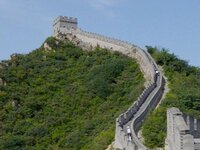Military engineer
|
|
A military engineer is primarily responsible for the design and construction of offensive, defensive and logistical structures for warfare. Other duties include the layout, placement, maintenance and dismantling of defensive minefields and the clearing of enemy minefields and the construction and destruction of bridges. In some cases an engineer may be required to destroy something that that same engineer designed and constructed.
In some countries, the modern military may comprise engineering units in say, weapon design or procurement, or of non-military civil engineering (e.g. flood control and river navigation works) which are not covered by this article.
In modern times a military engineer that usually operates during battle and under fire is called a combat engineer. For more modern aspects of military engineering and tools of the combat engineering corps, see combat engineering.
| Contents |
Defensive
Defensive fortifications are designed to prevent intrusion into the inner works by siege infantry. For minor defensive locations these may only consist of simple walls and ditches. The design principle is to slow down the advance of attackers to where they can be destroyed by defenders from sheltered positions. Most large fortifications are not a single structure but rather a concentric series of fortifications of increasing strength. Fortified cities would typically include an inner "old town"' within walls. Should the city be attacked, those residing outside the walls would enter the inner city. Within this would be a redoubt, or citadel, to which defenders could retreat should the walls or gates be breached.
The placement of mines to create minefields and their maintenance and disassembly is another defensive task.
When the defender must retreat it is often desirable to destroy anything that may be of use to the enemy, but particularly bridges, as their destruction can slow the advance of the attackers. The retreating forces may also leave booby traps for enemy soldiers, even though these often wreak their havoc upon non-combatant civilians.
Offensive
In ancient times, fortifications were assaulted by siege engines. These could be projectile throwing devices or simple moving towers that could allow attackers protection while positioning them above the top of the fortification's walls.
The undermining of the defender's walls by tunneling is called sapping. With the military use of gunpowder this explosive could be placed in tunnels to explode directly under the walls. The most spectacular use of this technique in the 19th century was during the United States' Civil War.
The clearing of enemy minefields is another offensive task.
Often the defender in retreat will destroy bridges to impede the attacker. These must be quickly replaced by the attacker in order to retain offensive mobility. In World War II a short portable bridge called the Bailey bridge could be quickly placed by a specialized transporter vehicle. Pontoon bridges have long been used as temporary replacements for destroyed river crossings.
Image gallery
The design, construction, and demolition of the works and devices shown would be the task of a military engineer in the appropriate era.
For a larger view of this gallery see Military engineer (images).
See also
- Military technology and equipment
- Bailey bridge
- Military engineering projects of World War II:
- Military engineers
- Civil engineer
- Royal Engineers
- Sapper






